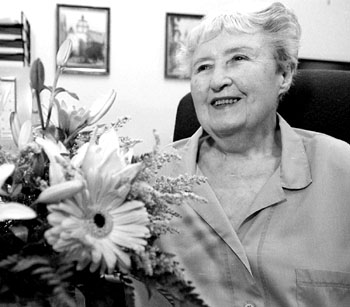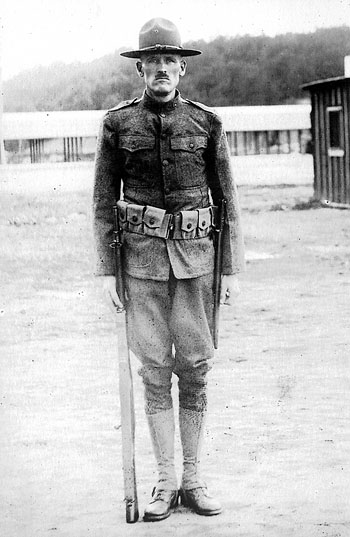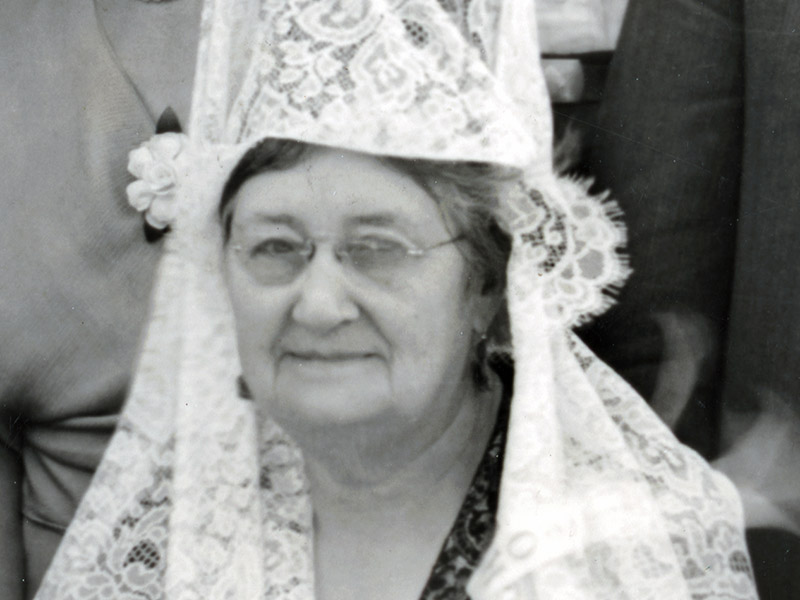|
|
Gladys Laney: Witness to 90 Years of History.
Lifelong Santa Clarita Valley resident has seen it all, from horse-and-buggy days to the computer craze.
By Margie Anne Clark
Wednesday, August 16, 2000
|
Of the passage of time, a philosopher once said: "Yesterday is but today's memory, and tomorrow is today's dream." For Gladys Laney, a life-long resident of Newhall, the passage of time has added up to a wonderful life, filled with special memories, about watching a small town grow, while she grew right along with it. There are the fond remembrances, but in the game of life, Laney was given a trump of diamonds, with four aces to spare, as she continues to bridge the past with the future, while living her 90 years to the fullest, as she fulfills tomorrow's dreams. "I've worked all my life," Laney said, "from the horse-and-buggy days to the new computer craze!" Still energetic, Laney worked as a secretary for Chitwood's and other furniture stores in the SCV, for most of her life. Laney recalled the days when there was no electricity, phones, or washing machines. All cooking was done with wood stoves, and lanterns provided light at night. Life was simpler, and quieter then, when Laney and the town of Newhall were only just beginning to blossom. Laney's journey began on July 16, 1910, when she was born in a small house in Newhall, on the corner of Newhall Avenue and Market Street. That was nearly 30 years after the town moved to Railroad and Sixth in 1878. Her father, Alexander Gilbert, better know as "Bert," and her mother, Armantha Thibaudeau, were of sturdy, hard-working, civic-minded stock, a legacy that would continue throughout Laney's life. Her father was a census-taker for part of his life, and he used to ride his horse up in the canyons to get to the houses in hills, the only way to reach those isolated farmsteads, at the time. Laney adored her father, a veteran of World War I, and an active member of his community. Her mother was a "joiner," as Laney puts it. Armantha was a member of many clubs and organizations, such as the American Red Cross, and other civic groups. Laney's great niece, Dixi DeWeiss, says that Laney inherited much of her own volunteer zeal from her parents. "She keeps a positive outlook, and accepts new challenges," DeWeiss said of her great-aunt. Her niece, Marjorie Mitchell agreed. "She's just a wonderful, pleasant, person." The town, at the time, was about two blocks long, with four saloons, a restaurant, two general stores, warehouses, the (second) Southern Hotel, and railroad station, on what is now called Railroad Avenue. There was also a livery stable owned by Ed Pardee, a friend of Laney's family.
But this was a momentous event, with the celebration taking place at the foot of the cascades in Sylmar, a good distance from where Laney's family lived. Nearly everybody in town made the trip to see William Mulholland himself, as he opened the water valve, make his now famous comment as the water poured forth, saying, "there it is, take it!" An engineering feat of its time, and still in use today, the aqueduct was designed to provide water to the city of Los Angeles. Parts of the large pipes of the aqueduct still can be seen today in various canyons throughout the valley. What Laney remembers most about the gathering was the fun she and her family had. They enjoyed the picnic and socializing, something her family was very fond of. She recalls her mother opening their home to many of their friends in the community on many occasions. Another big event Laney remembers from her early childhood was the Newhall Improvement Association's "Clean up Day" in the early 1920s. Just about every able-bodied person in town, including her mom and dad, gathered for the occasion. She was just a little more than 3 years old at the time. She remembers gathering on Spruce Street, a dirt road, which later became San Fernando Road. Her family always cared very much about taking pride in their community. Back in those small-town days, there were no strangers, and names that now seem so familiar were just townsfolk at the time. There was Berthe, "Bert" and Bailey Haskell, who owned property up in Saugus which is now known as Haskell Canyon. "She's been a great friend to me," Berthe Haskell recently said of their many years of being neighbors. Berthe Haskell and Laney loved to play bridge later in life. Laney is also good friends with Tom Frew IV, the son of Laney's Aunt Evangaline Atlantis. Laney remarked that Frew devoted much of his time to the community, a passion he continues to this day. He is active with the Newhall Redevelopment Committee and the Santa Clarita Valley Historical Society. Some dear childhood friends of Laney's were Naomi Lamkin and La Von Harker. The girls enjoyed spending time at each others' houses, where they would read together. They loved to read a variety of subjects. For fun, they enjoyed riding their bikes into town. Laney was also good friends with some of her nieces who were very close to Laney's age. Laney's sister was 18 years older than she, so her niece, Dorthey Brown, was actually one year older than she. Laney and Brown shared many fun times together. An old family story has circulated throughout the years about the time when Laney and Brown were still young girls. The story goes something like this. As Dorthey was learning to drive, she seemed to have trouble starting up the car once it had stopped. So one day, after several of the girls, including Gladys, had piled into the car that Dorthey was driving, they needed to stop and pick up some ice cream. Being that Dorthey did not want to stop the car, she slowed down just enough to let Gladys jump out. Then Gladys hopped back in when Dorthey came back around the corner! Of all of the changes Laney has witnessed throughout the years, she says that by far, the biggest change came about with the advent of the automobile. "The cars superseded everything," Laney said. Laney's family was good friends with the Ruby "Jenkins" Kellogg family. She remembers that the Kelloggs were the first in town to own a car, and what a thrill it was to ride the new Ford down to a place called Pico Canyon, which is now known as Mentryville. Laney and her friends just called it Pico in those days. She also enjoyed visiting the Kelloggs' two-story home, where she would spend her time running up and down the stairs while the grown-ups chatted in the parlor. Laney remembers going to elementary school at the old Newhall School on Ninth and Newhall Avenue. There were three large rooms to accommodate grades 1-8. Teachers were assigned to each grade level. There were no kindergarten grades at the time. The subjects they studied were the basics, reading writing and arithmetic. "We didn't have a great deal of science," Laney said. Baseball was the big sport back then, with a big rivalry between the boys at Saugus and Newhall elementary schools. She also remembers that the elementary school was a community gathering place of sorts, where the whole town would get together for a singing time. One of the highlights of her elementary years came when she was in fifth grade. She remembers that a small airplane had to make an emergency landing in a nearby field. "The teachers and everybody ran out to see the plane land. We all got to see the plane very close up!" Laney said. Shopping was simpler back then. Laney remembers going down to Mayhue's general store to shop for groceries and sundries. The store was owned by William Mayhue, who moved his family to Newhall from Tennessee. He and his family ran a boarding house and tended oil wells in the Rice Canyon fields. Back then the only payrolls were Standard Oil, The Newhall Land and Farming Co., and owning a shop in town. Later, the store would add a dance hall known as Hap-A-Lan, on the upper level, where Laney remembers her "flapper girl days." She loved to kick up her heels to the tune of the Charleston and other popular dances of the day. The town held dances every Saturday night there, and Laney and her family never missed a beat or an opportunity to get out and socialize with the townsfolk. Laney remembers some of the great disasters, as well as the good times. Among her other early memories, Laney talked about the great St. Francis Dam disaster of 1928. She was about 18 at the time, and attending high school in San Fernando (there was no high school in town) when the newspaper boys yelled out that Saugus had been flooded when the St. Francis Dam burst. "I didn't believe it at first," Laney said, but then as more news reports filtered in listing a death toll of at least 425 people, she knew it was true. It was the second-greatest disaster in the state's history, after the 1906 San Francisco earthquake. A morgue was set up at the Hap-A-Lan dance hall, and it was closed soon thereafter. She also remembers when the second Southern Hotel in the middle of town burnt down to the ground for the second or third time. The Southern Hotel was first built in 1893 by Henry M. Newhall's newphew Joshua and was considered to be the finest hotel outside of San Francisco. It burned down that same year and was rebuilt, although not in its original, grand Victorian style. Laney also recalled the years of the Great Depression. Families traveling from the midwest though California would stop in Newhall for several days. Laney's mom was there to help, through her work with the Red Cross. She would help to make sure that the travelers had a place to eat and rest. World War II brought about some changes in the valley, and Laney remembers when Bermite bought out the old Halifax Powder Co. in 1943, employing some 300 workers. Even as urban sprawl began to encroach on Southern California, the Santa Clarita Valley remained a bastion of small framers, cattlemen and shopkeepers. But change did come, and Laney has witnessed much of the city's transformation in recent years. She has some concerns that perhaps Santa Clarita is now growing too fast. But she concedes that, "change is just inevitable." Laney does her part to keep up with the times. She recently bought a new computer and is currently taking lessons at the SCV Senior Center where she works as a receptionist. She is also involved with the telephone reassurance program. She calls nearly 50 seniors a day to check in and see how they are doing. Laney works there five days a week from the morning until the afternoon. She lives just across the street from the center, and she enjoys walking to, and from, the center. Her co-worker, Elaine Howard, loves working with Laney. "I don't know what we would do without her. She's a very elegant, pleasant and dedicated lady," Howard said. "Working with her has just been a joy." Laney's greatest passion lately has been to polish her computer skills. She would like to be able to e-mail her friends in places such as Texas and Oregon. Another pastime she also enjoys is a good game of solitaire on the computer. Aside from boning up on her computer skills, Laney enjoys reading The Signal newspaper. She is known as "the historian" at the senior center, because of all the many articles she clips and puts into an album. She has been reading The Signal, ever since she can remember. Laney still enjoys visiting with her four nieces and four great-nieces. She also has four great-nephews, as well as four great-great-nephews and three great-great-nieces who think the world of her. As to her secret to living such a long and fulfilling life, she offers this simple bit of advice: "Volunteer. There's always a place for someone," Laney said. "I'm very content with my life." Originally published in The Signal | Used by Permission | Rights Reserved.
|
VIDEO ~2002
Prominent Newhall Women 1901
Gladys 1920s
Needhams (2) ~1930
Armantha Obituary 1961
Story 2000
July 4 Parade 2012
104th Birthday 2014
|
The site owner makes no assertions as to ownership of any original copyrights to digitized images. However, these images are intended for Personal or Research use only. Any other kind of use, including but not limited to commercial or scholarly publication in any medium or format, public exhibition, or use online or in a web site, may be subject to additional restrictions including but not limited to the copyrights held by parties other than the site owner. USERS ARE SOLELY RESPONSIBLE for determining the existence of such rights and for obtaining any permissions and/or paying associated fees necessary for the proposed use.









